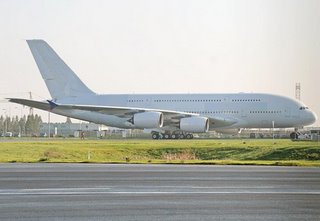 Oh for the happy days of July last, those "Europeans" must be thinking, when the aerospace giant, EADS, was riding high, having raised its profit growth target to 18 percent, on the back of its main subsidiary Airbus, which was doing particularly well, doubling its net profit to €816 million.
Oh for the happy days of July last, those "Europeans" must be thinking, when the aerospace giant, EADS, was riding high, having raised its profit growth target to 18 percent, on the back of its main subsidiary Airbus, which was doing particularly well, doubling its net profit to €816 million. Now, following the hubris of the A380 “super jumbo” launch in January last year, things are not looking quite so bright.
Shares of Airbus parent EADS have, in the last few days, tumbled on reports of serious technical problems with the A380, and new that core investors are jumping ship, having decided to slash their holdings in the Franco-German aerospace giant.
These are France's media group Lagardère and Germany's DaimlerChrysler, and each are to divest themselves of 7.5 percent of EADS shares.
Initially, this move was linked with reported delays in the delivery schedule for its biggest customer, Emirates Airlines, owing to late engine deliveries, but this was denied by Airbus.
Now, Ambrose Evans-Pritchard, at the Telegraph has come up with an altogether more plausible – and serious - reason why key shareholders have been so keen to divest some of their stocks.
It seems that the Franco-German pair signalled long ago that they would dispose of EADS stock, but this was not until the new A380 super-jumbo had been delivered to its launch customer, Singapore Airlines in December. But what Ambrose adds is that, six weeks ago, an A380 wing failed a stress test, having ruptured at 1.45 times the maximum design load, when the certification requirement is for it to be able to sustain a 1.50 load factor.
The wings are British-built, made from aluminium alloy and carbon composite panels baked in Broughton, North Wales - a novel and unproven technology in big jets and, it seems, the problem has yet to be resolved. The European Aviation Safety Agency (EASA) and the US Federal Aviation Agency (FAA) are both watching the situation.
While EADS is downplaying the failure, EASA is saying, "The fixed rule is 1.50 until otherwise specified, and we have not specified otherwise." The FAA in Washington is more adamant. "The standard is 1.50, and has to be met," says a spokesman.
This is seriously bad news for Airbus as the aircraft has suffered serious weight problems and the structure has since been lightened to meet weight targets. However, the test was done on the earlier, heavier structure and, if the wing has to be strengthened and this entails extra weight - or possibly a lower passenger load – this could trigger costly penalty clauses in sales contracts and reduce the desirability of the aircraft.
Nor is this the first time there have been safety fears about the A380. In October last there was a disturbing report about how contractors were taking short-cuts on key components, vital to the aircraft's safety.
Another report indicates other products are in trouble, especially the A340 long- range four-engine jetliner. Orders are down to almost nothing in relative terms - only 15 were ordered last year – while Dubai has informed Airbus that its flagship airline, Emirates, is postponing indefinitely an order for 20 A340-600 aircraft to wait for an improved version of the A340, which is more fuel-efficient. Yet, no decision is has been made to produce this version, while the Boeing competitor, its new twin-jet 777-200LR, which now holds the world non-stop distance record, is 24 percent more fuel-efficient.
The big problem, however, remains the A380. Already there are reports that the aircraft is set to make losses in excess of £4 billion over its commercial life and, as a result, Airbus will never repay the £2 billion-plus state aid paid to help launch it.
Noel Forgeard, Airbus chief executive, must be regretting the comment he made when the A380 was launched: "Under the name Airbus, Europe has written one of its most beautiful pages of its history," he said.
Quite.
COMMENT THREAD
No comments:
Post a Comment
Note: only a member of this blog may post a comment.